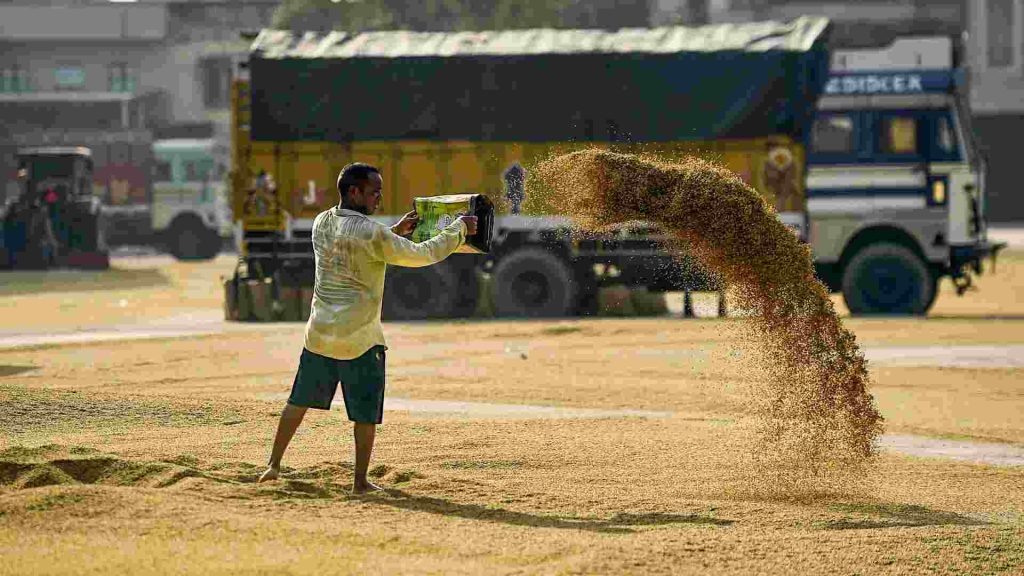Tags
India-Pak rice war deals a blow to Basmati growers
India-Pak rice war deals a blow to Basmati growers.

By Neeraj Mohan
Chandigarh: Indian Basmati rice farmers are facing a financial crisis, with a steep drop in paddy prices threatening their livelihoods. Prices have dropped by more than Rs 1,500 per quintal during the ongoing Kharif Marketing Season, with current rates between Rs 2,200 and Rs 2,600 per quintal, compared to last year’s Rs 3,500 to Rs 5,000. This sharp decline, especially in Haryana and Punjab, has left many farmers devastated, with some resorting to drastic measures such as dumping their produce on roads—a first in recent memory for the Basmati-producing region of Punjab.
The crisis stems from
इस शब्द का अर्थ जानिये
competitive actions between India and Pakistan, the two largest Basmati producers. On September 28, Pakistan’s Commerce Minister Jam Kamal Khan announced the removal of the Minimum Export Price (MEP) for rice varieties, a policy that had been in place since 2023. India had earlier lifted its own MEP of $950 per metric tonne for Basmati rice, which was followed by the lifting of the export ban on non-Basmati white rice and the introduction of a new MEP of $490 per metric tonne. This competition has led Pakistan to sell its rice at lower prices, allowing it to capture a larger share of the international market, at the expense of Indian exporters.
Market observers say this price war has had disastrous consequences for Indian farmers, with exporters and millers withdrawing from buying paddy in the northern mandis. This has caused a significant drop in demand in India’s largest Basmati-producing regions, particularly Haryana and Punjab. Farmers like Desh Raj from Nilokheri and Jagir Singh from Yamunanagar report losses of Rs 20,000 to Rs 30,000 per acre, with prices for premium Basmati varieties dropping below Rs 3,000 per quintal—well below the previous year’s average of Rs 4,000 to Rs 5,500 per quintal.
The situation is worsened by oversupply, as many farmers increased Basmati acreage last year when prices were favorable. Now, with stockpiles piling up in mandis and no buyers, the crisis has deepened. The rice industry has raised alarms over the government’s delay in implementing policy changes to stabilize the market. Vijay Setia, former president of the All India Rice Exporters Association (AIREA), said that while the government has taken steps based on recommendations from rice exporters, it will take time for the market to stabilize.
Adding to the challenges is the ongoing conflict between Israel and Iran, both of which are significant consumers of Indian Basmati rice. The tension between these two countries has caused Indian rice exporters to fear further losses, as trade disruptions and increased freight charges have discouraged traders. Setia explained, “The Israel-Iran war is another setback for rice exporters, as trade on these shipping lines has become risky, causing freight charges to rise.”
Reports indicate that Pakistan has expanded its Basmati cultivation area, intensifying the competition in the global market. As Pakistani exporters sell at lower prices, Indian traders are finding it difficult to compete. This situation has prompted Indian farmers to question the profitability of Basmati cultivation, with many wondering whether it is still a viable option. Government agencies in Punjab and Haryana only procure Parmal varieties under the Minimum Support Price (MSP) system, leaving Basmati farmers at the mercy of private traders who offer lower prices.
With average yields for premium Basmati varieties ranging from 14 to 20 quintals per acre, farmers are struggling to earn even Rs 50,000 per acre—a stark contrast to Parmal varieties, which yield 30 to 35 quintals per acre and fetch higher MSP rates of Rs 2,320 per quintal. Farmers and industry leaders are calling for immediate government intervention, urging the reintroduction of the MEP for Basmati rice and the imposition of stock limits to prevent traders from manipulating the market.
Praveen Kumar, an Ahrtia (commission agent) from Karnal, emphasized the need for government action, saying, “We need the government to step in and set clear policies that protect farmers’ interests and prevent further price crashes.” Without proper marketing systems or assured prices, farmers are left vulnerable, and the future of Basmati farming in Haryana and Punjab remains uncertain.
India remains the top exporter of Basmati rice globally, with exports in 2023-24 exceeding 5.24 million metric tons, valued at Rs 48,389 crore (approximately $5.8 billion). However, as the “Rice War” between India and Pakistan continues, the livelihoods of thousands of Indian farmers are hanging in the balance, waiting for crucial policy decisions from the government to stabilize the market and ensure the survival of Basmati cultivation in the country.
Published Date: October 6, 2024






